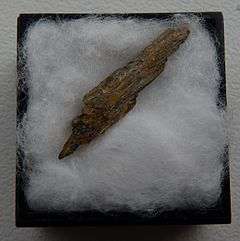Bismoclite
| Bismoclite | |
|---|---|
|
Yellow-orange bismoclite on bismuthinite from the Alto do Giz pegmatite, Equador, Rio Grande do Norte, NE-region, Brazil. Approximate size: 20 x 6 x 2 mm. | |
| General | |
| Category | Halide mineral |
| Formula (repeating unit) | BiOCl |
| Strunz classification | 3.DC.25 |
| Dana classification | 10.2.1.2 |
| Crystal system | Tetragonal |
| Crystal class |
Ditetragonal dipyramidal (4/mmm) H-M symbol: (4/m 2/m 2/m) |
| Space group | P4/nmm |
| Unit cell | a = 3.887 Å, c = 7.354 Å; Z=2 |
| Identification | |
| Color | Cream-white, greyish, yellowish brown |
| Crystal habit | Platey to thin rectangular crystals, firous to columnar, massive |
| Cleavage | {001} perfect |
| Tenacity | Elastic |
| Mohs scale hardness | 2-2.5 |
| Luster | Greasy, silky, pearly, dull, earthy |
| Streak | White |
| Diaphaneity | Transparent to translucent |
| Specific gravity | 7.36 (measured), 7.784 (calculated) |
| Optical properties | Uniaxial (-) |
| Refractive index | nω = 2.150 nε = 1.910 |
| Birefringence | δ = 0.240 |
| References | [1][2][3][4] |
Bismoclite is a bismuth oxohalide mineral with formula BiOCl. The name was derived from its chemical constituents. It is a secondary bismuth mineral composed of bismuthyl ions (BiO+) and chloride anions. It is a member of the matlockite group.
It was first described in 1935 from alluvium near bismuth-bearing pegmatites in South Africa.[2] It has been found in association with granite pegmatite and in greisen. Associated minerals include: bismutite, mica, jarosite, alunite, cerussite, atacamite, connellite. Occurrences include the type locality at Jackals Water, SW of Prieska, South Africa; Bygoo, Australia; the Tintic district in the East Tintic Mountains of Utah; and from Dalbeattie, Scotland.[3]
References
This article is issued from Wikipedia - version of the 12/2/2016. The text is available under the Creative Commons Attribution/Share Alike but additional terms may apply for the media files.
